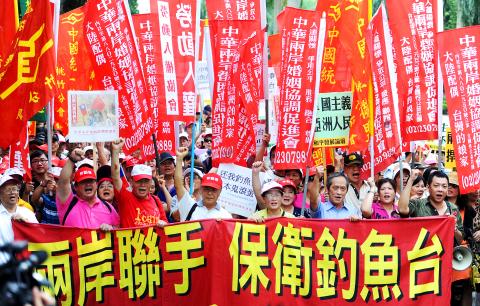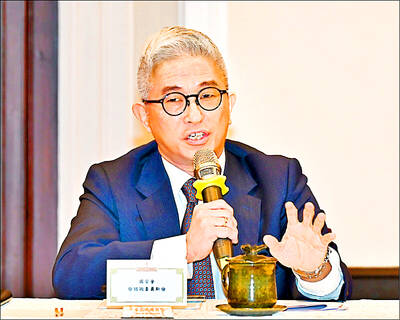About 1,000 people marched from Sun Yat-sen Memorial Hall to the Japanese representative office in Taipei yesterday to protest against Japan’s nationalization of three of the Diaoyutai Islands (釣魚台) and to urge Taiwan and China to collaborate in defending their sovereignty over them.
Chanting “the Diaoyutais are ours,” “the two sides of the Taiwan Strait should work to defend the Diaoyutais” and “down with Japanese imperialism,” the protesters, who mostly came from pro-unification groups — including the Labor Party, the Alliance for Reunification of China, the Chinese Association for the Defense of the Diaoyutais and the People’s Alliance for Defense of the Diaoyutais — marched from Sun Yat-sen Memorial Hall to the Taipei Office of the Interchange Association, Japan, the representative office of Japan in Taiwan.
“We’re opposed to proposals to share resources, such as fisheries, around the Diaoyutais with Japan before confirming that the Republic of China [ROC] has sovereignty over the islands,” People’s Alliance for Defense of the Diaoyutais convener Lin Hsia-hsin (林孝信) told the crowd before the march began. “It’s time for the two sides of the Taiwan Strait to put aside our differnces and work together for the sovereignty of the Diaoyutais.”

Photo: Lo Pei-der, Taipei Times
He asked “Without defending our sovereignty, how can we defend our fishing rights?”
A number of protesters carried People’s Republic of China (PRC) flags as they marched.
As they passed by the Pacific Sogo Department Store — a joint venture between Taiwan’s Pacific Construction Co (太平洋建設) and Japan’s Sogo Department Store — on Zhongxiao E Road, demonstrators chanted slogans urging a boycott of Japanese merchandise.
At one point, a man rushed a demonstrator holding a PRC flag, grabbed the flag, and asked: “Why are you holding this flag? Is this our national flag?”
The two men briefly engaged in a clash before being separated by others.
Chang Chih-min (張志民), another demonstrator who carried a PRC flag, defended the use of the Chinese flag.
“I am Chinese, there is only one China and there is nothing wrong in holding a Chinese flag,” he said. “I am displaying a Chinese flag, so the Japanese will know that Taiwan is backed by its motherland and will cease being so arrogant.”
A shouting match also broke out between a demonstrator and China Times reporter Chen Wen-hsin (陳文信), who was on the scene to cover the protest and wore a sun hat with neck protection.
The demonstrator told Chen he should not wear such a hat, because “that’s the kind of hat that the Japanese soldiers wore when they invaded China.”
“But I am Taiwanese, what you just said is not appropriate,” Chen replied, to which the demonstrator responded: “You young people should learn some history.”
The dispute ended with Chen walking away after saying: “You are very rude.”
Demonstrators gathered outside the Interchange Association, Japan at about 4pm and delivered a letter of protest to Economic Affairs Director Masahiko Sugita.
The letter urged Japan to “return the Diaoyutais immediately to Taiwan. Do not create more hatred in Asia and do not create more enemies for generations to come.”
Clashes then broke out between pro-unification demonstrators and a pro-independence demonstrator, Yang Tzu-fu (楊梓富).
Pro-unification demonstrators were upset by a banner displayed by Yang, which said that the waters surrounding the Diaoyutais were historical fisheries for Taiwanese fishermen and that Taiwan is not part of China.
“What do you mean Taiwan is not part of China?” a pro-unification demonstrator asked, approached. “This is nonsense! You stupid Taiwan independence supporter!”
Meanwhile, the Presidential Office said it welcomed the peaceful method by which Taiwanese had expressed their opinions on the Diaoyutais, adding that as Taiwan was a democratic society, the government would do everything to uphold citizens’ right to express their opinions on the issue.
At a separate event, a group of fishermen announced that 60 Taiwanese fishing boats from Yilan County would set sail today for the Diaoyutai Islands to safeguard Taiwanese fishermen’s trawling rights in waters near the resource-rich island chain.
The action is to mark the first large-scale attempt by Taiwanese fishermen to bolster their right to fish near the Diaoyutais since the territorial dispute reached a new level following a Sept. 11 announcement by the Japanese government that it had nationalized three of the islands in the chain.
Former Yilan County Longline Fishing Association director Lin Jih-cheng (林日成), who is to serve as commander for the mission, said that in addition to the 60 fishing boats, which are to set sail from Suao Township (蘇澳) at 3pm today, more fishing vessels operating near the island group are also expected to take part.
“These fishing vessels are scheduled to converge at 20 nautical miles [37km] southwest of the islands at 5am on Tuesday and sail clockwise around the chain in a move to claim Taiwanese fishermen’s fishing rights in the water area,” the Chinese-language United Evening News reported reported Lin as saying.
The vessels could approach up to 12 nautical miles of the contested archipelago, Lin said, adding that the mission did not include landing on the islands.
The vessels will return to the Nanfangao fishing harbor in Suao on Wednesday morning.
“The mission aims to make sure our voices are heard by the Japanese and serves as a test to see how much emphasis the government will put upon Taiwanese fishermen,” Suao Fishermen Association director Chen Chun-sheng (陳春生) said, after an earlier mission was postponed due to a failure to obtain NT$5 million (US$170,000) in fuel subsidies from Yilan County Government.
The archipelago — claimed by Taiwan, China and Japan — is currently registered under the jurisdiction of Yilan County in Taiwan.
“We are defending our fishing rights by ourselves,” Chen said, adding they were only able to carry out the postponed action after receiving a NT$5 million donation.
Chen said the vessels are to fly banners with slogans defending their fishing rights, while participating fishermen are to wear a T-shirt with the words: “Fighting for fishing rights to survive” on the front and a Republic of China (ROC) flag printed on the back.
A “secret counter-attack plan” is also on standby should the Japanese coast guard dispatch vessels to jeopardize the sail, Chen said, declining to give details.

A car bomb killed a senior Russian general in southern Moscow yesterday morning, the latest high-profile army figure to be blown up in a blast that came just hours after Russian and Ukrainian delegates held separate talks in Miami on a plan to end the war. Kyiv has not commented on the incident, but Russian investigators said they were probing whether the blast was “linked” to “Ukrainian special forces.” The attack was similar to other assassinations of generals and pro-war figures that have either been claimed, or are widely believed to have been orchestrated, by Ukraine. Russian Lieutenant General Fanil Sarvarov, 56, head

SAFETY FIRST: Double the number of police were deployed at the Taipei Marathon, while other cities released plans to bolster public event safety Authorities across Taiwan have stepped up security measures ahead of Christmas and New Year events, following a knife and smoke bomb attack in Taipei on Friday that left four people dead and 11 injured. In a bid to prevent potential copycat incidents, police deployments have been expanded for large gatherings, transport hubs, and other crowded public spaces, according to official statements from police and city authorities. Taipei Mayor Chiang Wan-an (蔣萬安) said the city has “comprehensively raised security readiness” in crowded areas, increased police deployments with armed officers, and intensified patrols during weekends and nighttime hours. For large-scale events, security checkpoints and explosives

‘POLITICAL GAME’: DPP lawmakers said the motion would not meet the legislative threshold needed, and accused the KMT and the TPP of trivializing the Constitution The Legislative Yuan yesterday approved a motion to initiate impeachment proceedings against President William Lai (賴清德), saying he had undermined Taiwan’s constitutional order and democracy. The motion was approved 61-50 by lawmakers from the main opposition Chinese Nationalist Party (KMT) and the smaller Taiwan People’s Party (TPP), who together hold a legislative majority. Under the motion, a roll call vote for impeachment would be held on May 19 next year, after various hearings are held and Lai is given the chance to defend himself. The move came after Lai on Monday last week did not promulgate an amendment passed by the legislature that

PENTAGON ASSESSMENT: A US report said that even as China and Russia deepen their partnership, cooperation is hindered by a ‘mutual distrust’ of each other The Chinese People’s Liberation Army (PLA) as of October had doubled the number of ships and airplanes deployed around Taiwan compared with the previous two years, Vice Minister of National Defense Hsu Szu-chien (徐斯儉) said yesterday, a day after the opposition-controlled legislature voted against reviewing the government’s general budget for next year, including a NT$1.25 trillion (US$39.71 billion) special defense spending bill. The legislature’s vote against the Ministry of National Defense’s spending plans was regrettable, as the budget was designed to respond to the developing Chinese military threat, Hsu said on the sidelines of a legislative meeting on the general budget. Defense